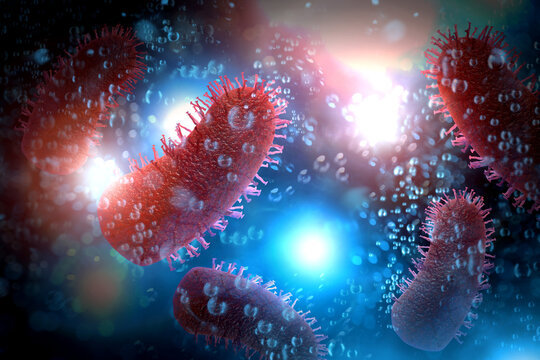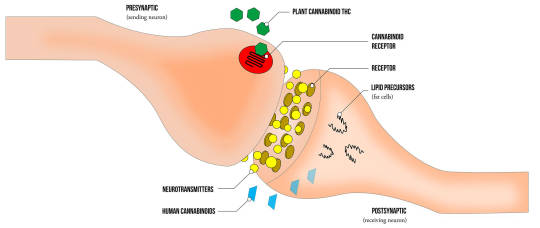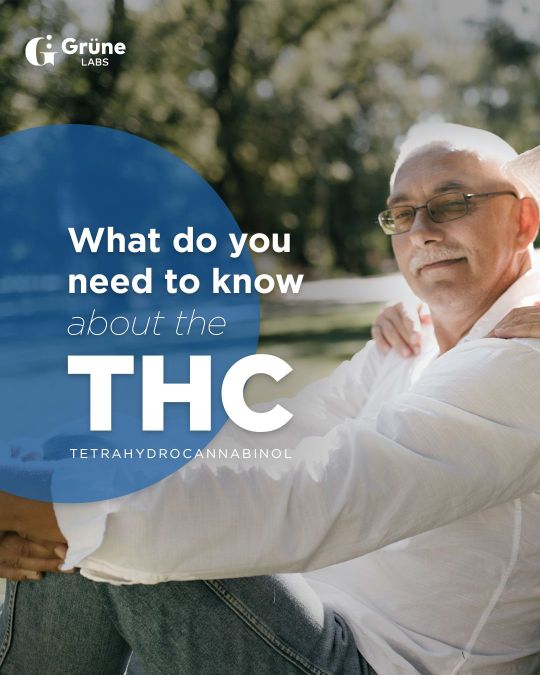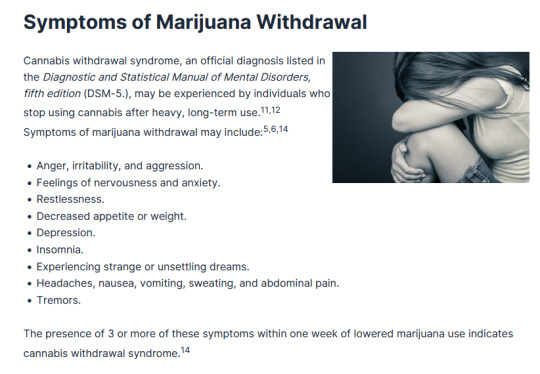#endocannabinoids
Text
.
To be clear, Omega-6 fat is an essential nutrient for human health. The problem lies in excess consumption and what it does. First up, we make a few endocannabinoids from it. One of them makes us hungry, same as pot giving us the munchies. It also mobilizes certain stem cells to become fat cells. This is the nasty bit they are talking about in the article above.
Omega-6 fat is also the substrate of most inflammation in the human body. The more overdosed we become on Omega-6, the more likely we are to develop a chronic inflammatory disease like arthritis, asthma, allergies, diabetes, depression, etc...
5 gm / day, is near the top of the healthy range for large humans like myself, and it is not all that simple to do. Like wheat, they put it in most industrially processed foods because it is slow to go rancid. I could make more sinister accusations, but they weren't that smart when they started doing it, though they clearly are now.
.
7 notes
·
View notes
Text
The Impact of Rabies on the Endocannabinoid System: Unraveling the Connection
World Rabies Day 28th September

Introduction
Rabies, a deadly viral disease that affects the nervous system, has long been a cause for concern worldwide. While its effects on the central nervous system are well-documented, recent research has shed light on the impact of rabies on the endocannabinoid system. This article aims to explore this intriguing connection and understand how rabies affects the delicate balance of the endocannabinoid system.
Understanding Rabies
Rabies is primarily transmitted through the bite or scratch of an infected animal, typically dogs, bats, or other wildlife. Once the virus enters the body, it travels to the brain, causing inflammation and neurological symptoms. Rabies can be classified into two forms: furious rabies, characterized by aggressive behaviour, and paralytic rabies, which leads to muscle weakness and paralysis.
The Endocannabinoid System

The endocannabinoid system (ECS) is a complex network of receptors, endocannabinoids, and enzymes that play a crucial role in maintaining homeostasis within the body. It regulates various physiological processes such as pain sensation, mood, appetite, and immune response. The ECS consists of two main receptors, CB1 and CB2, which are found throughout the body, including the brain.
Impact of Rabies on the Endocannabinoid System
Recent studies have indicated that rabies infection can disrupt the functioning of the endocannabinoid system. The virus affects the CB1 receptors in the brain, leading to altered neurotransmission and impaired signalling. This disruption may contribute to the behavioural changes observed in individuals infected with rabies, such as aggression and hyperactivity.
Inflammation and Immune Response

Rabies infection triggers a robust inflammatory response in the brain, leading to encephalitis. This inflammation can further impact the endocannabinoid system, as inflammatory mediators can interfere with the normal functioning of CB1 receptors. The dysregulation of the ECS due to inflammation may contribute to the neurological symptoms associated with rabies.
Conclusion
The connection between rabies and the endocannabinoid system highlights the intricate relationship between viral infections and the body's regulatory systems. While much remains to be discovered, studying the impact of rabies on the ECS may provide valuable insights into the development of novel treatment strategies. By unravelling this complex interplay, researchers can pave the way for improved outcomes for individuals affected by this devastating disease.
#rabies#rabies awareness#endocannabinoidsystem#endocannabinoids#cannabis#cbd#health#feelgreatagain#budandtender
2 notes
·
View notes
Photo

With our Lean Body Pack, you may contour your body internally and externally. Details can be found at https://livegood.com/GreatLife. #healthandwellness #LIVEGOOD #healthyliving #healthcare #lowcost #LiveGoodHealthClub #supplements #nutrition #CBD #endocannabinoids #nutraceuticals https://www.instagram.com/p/Cm_SNLau0e-/?igshid=NGJjMDIxMWI=
#healthandwellness#livegood#healthyliving#healthcare#lowcost#livegoodhealthclub#supplements#nutrition#cbd#endocannabinoids#nutraceuticals
2 notes
·
View notes
Text
Unique Influencers - Specialized Roles of Neurochemicals
Explore the specialized roles of dynorphins, neuropeptide Y (NPY), and endocannabinoids in shaping our emotions, pain perception, and stress resilience.
The Unique Influencers: Specialized Roles of Neurochemicals
In the intricate dance of the human body, a cast of microscopic influencers wields the power to shape our emotions, guide our decisions, and color our experiences. Beyond the usual suspects like dopamine and serotonin, known for their headline-grabbing roles in pleasure and mood, lies a fascinating ensemble of neurochemicals. These…

View On WordPress
#Appetite Control#Diet#Dynorphins#Emotional Regulation#Endocannabinoids#Exercise#Immune System#Mindfulness#Neurochemicals#Neuropeptide Y#Pain#Pain regulation#Reduce Alcohol#Sleep#Social Interaction#Social Support#Stress#Stress Reduction
0 notes
Text
Tetrahydrocannabinol (THC) is one of the most studied compounds in the #cannabisplant, but to think that the entire pharmacology of the cannabis plant boils down to this compound is far from the truth. #THC is also the main psychoactive component of cannabis.
THC has a molecular structure of 21 carbon atoms, 30 hydrogen atoms and two oxygen atoms.
THC is chemically similar to the body's #endocannabinoids, which allows it to interact with cannabinoids and other receptors.
The interaction of THC with cannabinoid receptors affects the release of neurotransmitters, chemicals responsible for transmitting messages between cells and have roles in #pain, immune function, #stress and #sleep, among others.
Professor Mechoulam carried out the identification and isolation of the molecular structure of THC in 1964.
🔍 THC is a partial agonist of CB1 and CB2 receptors in the brain, centrally and peripherally, showing analgesic, antipruritic and bronchodilator effects and therefore used in treating asthma. It is also a potent neuroprotective antioxidant, helping to prevent brain damage.
In addition to its activity on the CB1 receptor, THC is a potent analgesic and anti-inflammatory via non-CB1. It shows 20 times the anti-inflammatory potency of aspirin and two times that of hydrocortisone. But it doesn't inhibit COX-1 and COX-2, nor present the same cardiovascular risk as typical NSAIDs.
It is also a potent muscle relaxant, approved in treating spasticity associated with #MultipleSclerosis, namely a drug, with a standardised dose, and a THC:CBD 1:1 ratio, which releases 2.7mg of THC and 2.5mg of CBD, in each application (nabiximols). And, of course, THC is a potent antiemetic, particularly in #chemotherapy treatment situations. It is the basis for the synthetic cannabinoid Marinol® creation, approved for treating chemotherapy-induced nausea and vomiting in the USA.
Besides, THC apparently inhibits beta-amyloid plaque formation, associated with #Alzheimer's disease pathophysiology.

1 note
·
View note
Text
I’m coming to some conclusions here...
Growing up a was relatively happy child, moreso noticeably a very very silly and giggly child. We used to joke that my brain naturally made its own marijuana. Well, that’s not entirely untrue -

The endocannabinoid system is really important in the regulation of a lot of stuff - you know, for example, the kind of things in which a deficiency thereof leads to things like... oh, I don’t know.... Major Depressive Disorder. And Generalized Anxiety. And regulating blood pressure. You know, all the shit I suffer from
Below: All the symptoms that began to onset as I got older

Not listed:
Temperature control. I am hot, all the god damn time
Immune functioning - before addressing my Depression, I was getting sick all the the gottdangt time
Learning and memory: At the height of my Depression, I couldn’t remember a damn thing and it was really frustrating. I still deal with it from time to time
At some point, my brain either stopped producing the needed neurotransmitters for these regulations, or growing up it was over-producing and lead to neural burnout akin to kids who were heavy marijuana users
So I don’t really know what to make of all this information, but it’s just one of those “by writing it down it helps me process it better” type things
#endocannabinoids#endocannabinoid system#depression#anxiety#mental health#adhd? maybe?#personal#random personal shit
0 notes
Photo

#Repost @cannabispharmd ・・・ What if I told you Anandamide is only the beginning of the story, and that the health of your endocannabinoid system is driven mostly by your lifestyle and diet? What if your essential fatty acids were essential because they support your ECS? What if these #endocannabinoids could create new neurons, or help existing neurons start communicating. Well… That is all true. And it turns out that the other endocannabinoids may even be MORE important than Anandamide or 2-AG! Comment with questions! Kim, H. Y., & Spector, A. A. (2013). Synaptamide, endocannabinoid-like derivative of docosahexaenoic acid with cannabinoid-independent function. Prostaglandins, leukotrienes, and essential fatty acids, 88(1), 121–125. doi:10.1016/j.plefa.2012.08.002 (at Washington Heights (Manhattan)) https://www.instagram.com/p/CqG632RMMQU/?igshid=NGJjMDIxMWI=
0 notes
Text
Is Your Endocannabinoid System (ECS) Depleted?
Is Your Endocannabinoid System (ECS) Depleted?
Did you know that you have an Endocannabinoid System (ECS) inside of your body? That is where you will find cannabinoid receptors because you create endogenously (inside of your body) what are called ‘endocannabinoids’. Over time, and with stressors – be it environmental, emotional, or physical – this system gets depleted and you have more difficulty creating endocannabinoids inside of…

View On WordPress
0 notes
Text
Buy Psychedelic Online at Cocaine laboratory approved Psycho Supplies
#usa#online#pharmacy#onlineshopping#onlineshop#onlinestore#onlineboutique#shoppingonline#shoponline#onlinebusiness#usahaonline#onlineart#onlineshopsemarang#cannabinoids#endocannabinoidsystem#phytocannabinoids#endocannabinoids#cannabinoidsystem#cannabinoidscience#cannabinoidsheal#cannabinoidscure#cannabinoidsnotopioids#minorcannabinoids#nohypejuscannabinoids#cannabinoidsupplementation#fullspectrumcannabinoids#cannabinoidseeds#cannabinoidsoul#cannabinoidsoil#endocannabinoidsupport
1 note
·
View note
Text
I love runningggggggg I love trail running, I love to move my body and breathe so deeply and be in the woods. Love 2 b a sweaty hairy animal and part of the world
#I was soooooo high on the endocannabinoids after yesterday's run lol#like enough that I seemed actually high and N remarked on it#also I did such a good job hydrating that I peed as soon as I got home instead of hours later :)#2.5 liters of water during that run. proud of myself#and a snack every 2-3 miles
4 notes
·
View notes
Text
this weed education certificate is kind of fun but all i can think abt is how much the voice sounds like the missile
8 notes
·
View notes
Text
Husband decided to mix the mulberry juice with the seabuckthorn juice, which we used to chase a pomegranate infused vodka. As my edible kicked in, I'm pretty sure I vibrated at the cellular level. That's a lot of micronutrients.
7 notes
·
View notes
Text
Unveiling the Mind's Green Secret: How Endocannabinoids Shape Mental Health
World Suicide Prevention Day 10th September

Introduction
Mental health is a complex and multifaceted aspect of our overall well-being. Various factors contribute to the development and maintenance of mental health disorders, including genetics, environment, and neurobiology. In recent years, there has been growing interest in the role of endocannabinoids in influencing mental health. Endocannabinoids are naturally occurring compounds within our bodies that interact with the endocannabinoid system, which plays a crucial role in regulating various physiological processes. This article aims to explore the influence of endocannabinoids on mental health, focusing specifically on their effects beyond the medical use of CBD.
Understanding the Endocannabinoid System
To comprehend how endocannabinoids influence mental health, it is essential to have a basic understanding of the endocannabinoid system (ECS). The ECS consists of three main components: endocannabinoids, receptors, and enzymes. The two primary endocannabinoids are anandamide (AEA) and 2-arachidonoylglycerol (2-AG), which bind to cannabinoid receptors (CB1 and CB2) located throughout the central nervous system and peripheral tissues. These receptors modulate various physiological processes, including mood, stress response, and cognitive function.

How endocannabinoids influence mental health
Regulating Emotional States: Endocannabinoids have been linked to the regulation of emotional states, including mood and anxiety. Studies suggest that anandamide, one of the primary endocannabinoids, interacts with CB1 receptors in brain regions associated with emotional processing, such as the amygdala and prefrontal cortex. By modulating neurotransmitter release and synaptic plasticity, endocannabinoids contribute to the regulation of mood and emotional responses.
Stress and Resilience: Stress is a significant factor that can impact mental health, and the ECS appears to play a crucial role in modulating the stress response. When faced with stress, the release of endocannabinoids is enhanced, which helps to dampen the stress response and restore homeostasis. The activation of CB1 receptors in brain regions involved in stress regulation, such as the hypothalamus and hippocampus, can reduce the release of stress hormones, thereby promoting resilience and emotional stability.

Neuroplasticity and Neurogenesis: Neuroplasticity, the brain's ability to reorganise and form new connections, is fundamental for learning and memory processes. Endocannabinoids have been found to play a role in modulating neuroplasticity by facilitating synaptic plasticity and neuronal communication. Furthermore, emerging evidence suggests that endocannabinoids may also promote neurogenesis, the formation of new neurons in certain brain regions, including the hippocampus. These processes are essential for mental well-being and cognitive function.
Endocannabinoids and Mental Disorders: Given the involvement of endocannabinoids in various aspects of mental health regulation, it is unsurprising that alterations in the ECS have been associated with mental disorders. Studies have linked dysregulation of the ECS to conditions such as depression, anxiety disorders, post-traumatic stress disorder (PTSD), and schizophrenia. Understanding these associations provides insights into potential therapeutic targets and the development of novel treatments.
Conclusion
Endocannabinoids play a significant role in influencing mental health by regulating mood, stress response, cognitive function, and reward-related behaviours. Understanding the intricate interplay between endocannabinoids and the endocannabinoid system can provide valuable insights into the development and treatment of mental health disorders. Further research is needed to fully comprehend the complexities of this system and its potential therapeutic implications. By unravelling the mysteries of endocannabinoids, we may pave the way for novel approaches to enhance mental well-being.
If you want to help raise awareness about mental health, you can donate here to Mental Health UK.
#health#mental health#mental health awareness#endocannabinoids#endocannabinoidsystem#cbd#cannabis#health and wellness#feelgreatagain#budandtender
2 notes
·
View notes
Photo

The endocannabinoid system: Essential and mysterious
The first endocannabinoid that was discovered was named anandamide after the Sanskrit word ananda for bliss. All of us have tiny cannabis-like molecules floating around in our brains. The cannabis plant, which humans have been using for about 5,000 years. Peter Grinspoon, M.D.
https://www.health.harvard.edu/blog/the-endocannabinoid-system-essential-and-mysterious-202108112569
2 notes
·
View notes
Text
Body Mechanics - Neurochemicals in Physical Response and Regulation
Neurochemicals in Physical Response and Regulation. Learn ways to regulate and optimize your brain body connection.
Welcome to Blog Post 3 in our series: “Body Mechanics – Neurochemicals in Physical Response and Regulation.” We now shift our focus from the intricate workings of the mind to the dynamic world of neurochemicals that govern our physical responses and bodily functions. It’s a journey into understanding how these microscopic marvels orchestrate the symphony of our physical experiences.
Your body…

View On WordPress
#Adrenaline#Balanced Diet#body#CCK#Cholecystokinin#Coping#Endocannabinoids#Epinephrine#Fight or Flight#GABA#Healthy#Hydration#Melatonin#Neurochemicals#Professional Help#psychology#relax#Relaxation#Sleep#Stress#Stress Management#Substance P#Vasopressin
0 notes
Text
Many of us have heard of some of the transmission systems found in the human body. Take, for instance, the sympathetic nervous system, which triggers the fight-or-flight response. However, less has been heard of the more recently discovered endocannabinoid system, or ECS. This is rather surprising considering that it could be fundamental to almost every aspect of our bodily functions. Here we explain it in detail to help you understand how cannabis produces its effects.
The endocannabinoid system comprises a vast network of chemical signals and cell receptors which are densely packed in our body. For example, the ‘cannabinoid’ receptors in the brain outnumber many other types of receptors that are affected by different neurotransmitters.
Neurotransmitters are molecules used by the brain cells, or neurons, to communicate with each other. One neuron sends a message to the next neuron by releasing certain neurotransmitters, such as dopamine or serotonin, in an infinitesimal space that separates a neuron from the next.
Read the full post here: https://www.kannabia.com/en/blog/how-does-endocannabinoid-system-works
#cannabinoids#neurotransmisores#endocannabinoid system#cannabis#kannabia#kannabia blog#kannabia seeds#cannabis culture#medical cannabis#cbd#cannabiscommunity#therapeutic marijuana#medical marijuana
3 notes
·
View notes